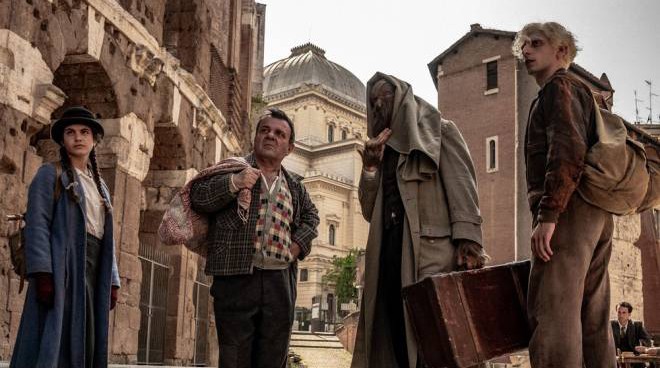The Green Knight
To attempt to render on the silver screen the arthurian legend that is most dense in ancestral allusions and meanings is as dangerous a quest as the one undertaken by Sir Gawain in the story. Yet, David Lowery's The Green Knight is perhaps the closest that an endeavor of this sort could reach, in order to achieve such an aspiration.
 |
However fascinanting it may be, the original text of “Sir Gawain and the Green Knight” is rather poor in reporting events and incidents that do not belong to the few key moments of the myth. As a consequence, an entirely faithful adaptation would certainly not be able to feature lenght. Even worse, the conventionalised nature of the epic poem would lead to a very repetitive set of instances and actions.
French director Eric Rohmer had directed a film version of one of the arthurian works written by Chrétien de Troyes, "Perceval le Gallois" with absolute fidelity to the conventional and artificiality of the medieval novel, and hardly succeeded in transferring the story in a truly engaging manner. It ends up being a mere excersise in style, a depiction of the beauty of the literary work, but devoid of its inherent mystical aura.
On the opposite side, cinema has too often ravaged the arthurian legends, transforming them into grand scale blockbusters that have little in common with the original work, aside from the basic structure and the names of characters.
Fortunately, neither is the case of The Green Knight.
The approach that Lowery has taken is that of maintaining the flavour of the original text and expanding some of the scenes that are only briefly mentioned. A glaring example is Sir Gawain's encounter with giants. The scene is inspired by a single verse that mentions that the knight has traveled through the "land of the giants", without further elaboration, whereas the scene of the film enacts a precise series of events. As a result of this approach, whoever is familiar with the text perceives a dominating adherence, despite the continuous presence of additions and modifications, most of which are loyal to the source.
An important addition by the director of A Ghost Story is the implementation of a similar, quasi quantum understanding of reality. A scene that was visible in the trailer carifies this easily: when Gawain is left by raiders tied up in the forest, a horizontal pan moves out to the forest, and then back to bones that lay on the ground where he was. The pan repeats and the viewer sees Gawain alive again. A similar, more complex sequence will occur later on in the film. This choice might convey the idea that the story is just one of the variables, or to display the consequences of Gawain’s acts, or even to increase the paranormal atmosphere that permeates throughout the film.
It is tempting to identify explanations and specific interpretations in the tale of the Green Knight. A contemporary viewer might see in Sir Gawain and the Green Knight’s competition a personification of the opposition between nature and humanity.
In truth, it is a story open to a whole wide range of very different interpretations and meanings, of esoteric truths or christened ancestral pagan symbolisms. This mystical, hermeneutic domain is not only maintained in the film, but enhanced even. The film never ceases to present a transcendental sphere that does not beg for interpretation as much as for a suspension of disbelief.
The conclusion of the poem is purposefully bitter and unrewarding, and so is the ending of the film. The way this sentiment is achieved by the two works is however different. The film necessarily manifests it through non a non-verbal dimension, through a visual fluidity broken by abruptness. The narration is interrupted earlier than some revelations that occur in the poem, thus causing a sense of frustration, equal to the one experienced by Gawain in the poem, but through different means.
Ultimately, the film requires the viewer's acceptance of an unrewarding conclusion and few idiosyncrasies that may come off as flaws, be it the chapter titles, the somewhat unusual use of certain types of transitions, or abrupt cuts. Elements that can be bothersome as much as appealing, that can be totally ignored if the receiving party has managed to be raptured by the adventure.


Comments
Post a Comment